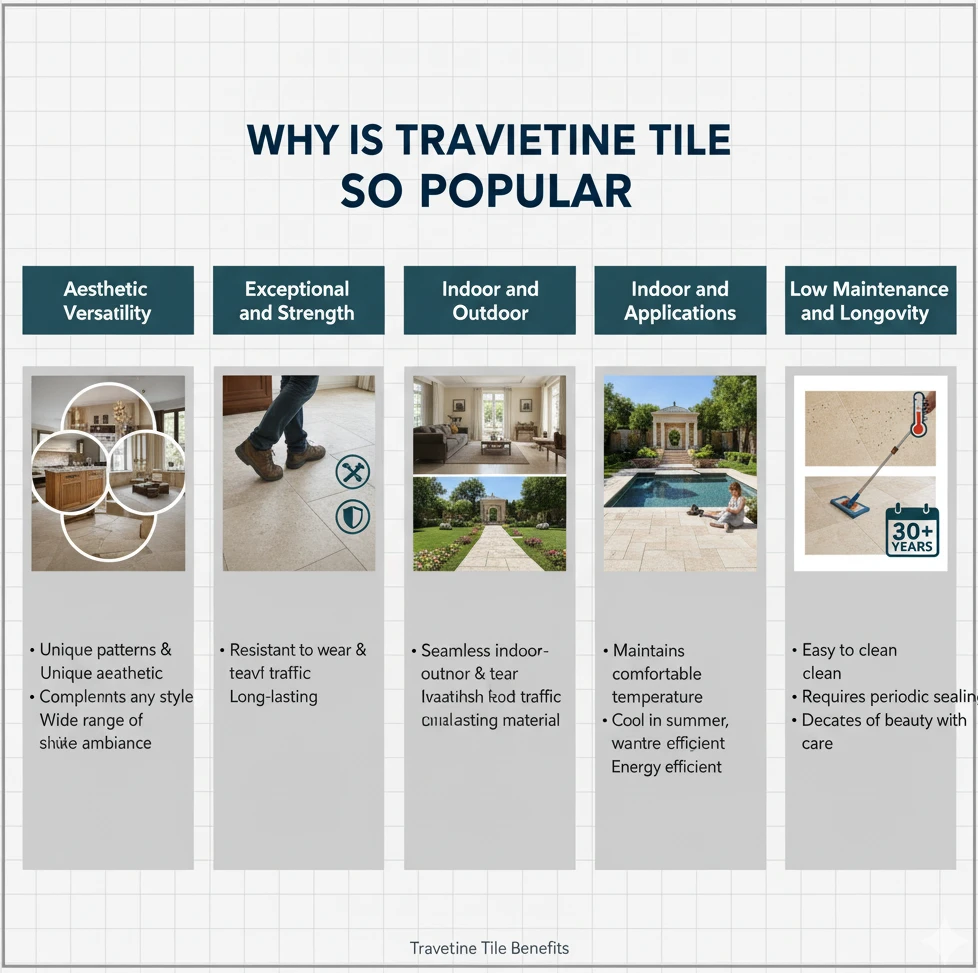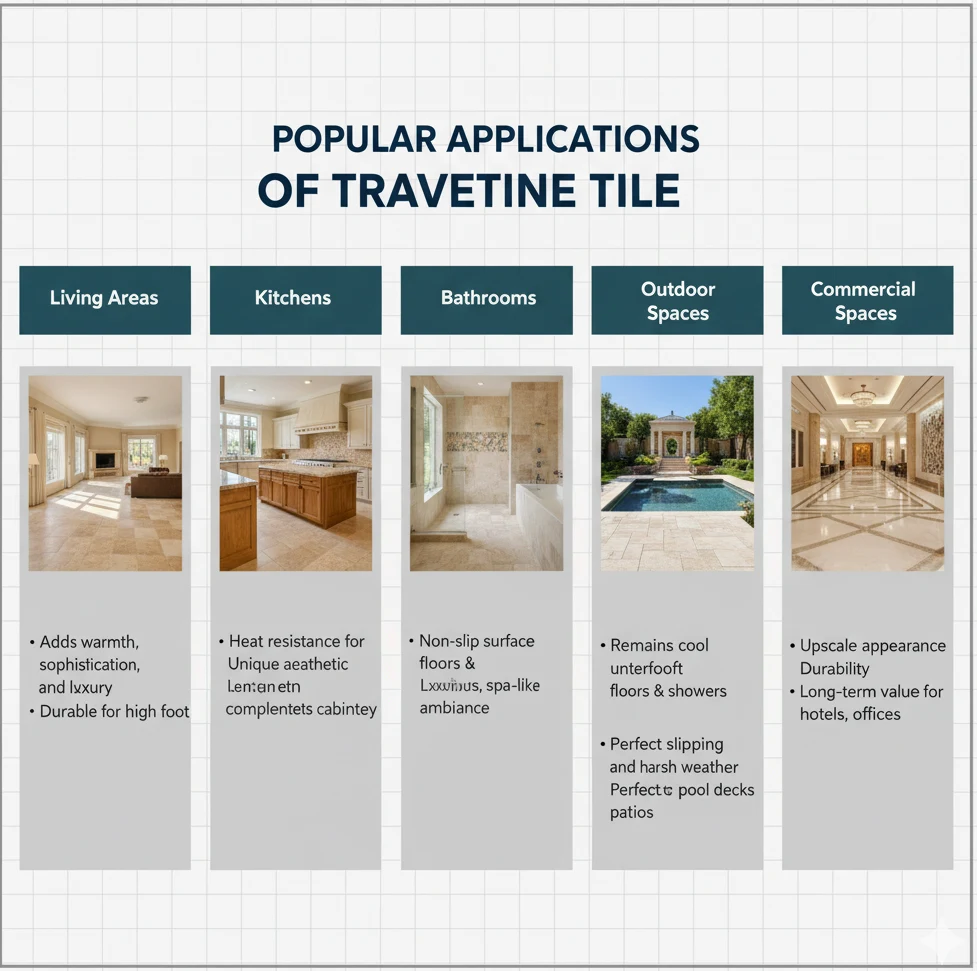8 November, 2025

Introduction: The Timeless Appeal of Travertine Tile
Travertine tile, a natural stone created over thousands of years from mineral-rich spring deposits, has been admired for centuries for its unparalleled elegance, exceptional durability, and remarkable versatility in design. From ancient Roman structures to luxurious modern homes, travertine has stood the test of time, offering an aesthetic appeal that blends seamlessly with both traditional and contemporary interiors. Its distinct porous texture, natural veining, and earthy color palette make it a material of choice for homeowners, architects, and designers who want to achieve a look that is both sophisticated and enduring, while also benefiting from a stone that can withstand the test of time.
What Is Travertine Tile?
Travertine is a type of limestone that forms naturally in hot springs, mineral-rich waters, and limestone caves over thousands of years, resulting in a stone that is both visually striking and structurally resilient. Characterized by a fibrous, porous surface, travertine tiles offer a natural variation in texture and color that cannot be replicated by synthetic materials, giving each tile a unique identity and charm. Travertine tiles are available in several finishes, each designed for specific aesthetic and functional purposes:
-
Honed: This finish provides a smooth, matte surface that is ideal for areas with high foot traffic, offering understated elegance while reducing the visibility of scratches and wear over time.
-
Polished: A polished finish enhances the depth of the natural colors and intricate veining patterns, creating a glossy, reflective surface that elevates the visual appeal of luxury interiors.
-
Tumbled: Tumbled tiles are intentionally aged and distressed to create a rustic, antique look with rounded edges, making them perfect for outdoor applications such as patios, terraces, and pool decks.
Travertine tiles are available in a diverse range of natural shades, including beige, ivory, grey, brown, and white travertine tile, allowing homeowners to customize the look of their floors, walls, and outdoor areas. The natural variation in color and texture ensures that no two tiles are identical, adding a sense of authenticity and sophistication to any design project.
Why Is Travertine Tile So Popular?

Aesthetic Versatility
Travertine tiles are renowned for their timeless beauty and ability to complement any design style, from rustic Mediterranean homes to sleek, modern minimalist interiors. Available in a variety of shades such as ivory travertine, grey travertine tiles, beige travertine tile, and brown travertine tile, these tiles can easily be matched with furniture, cabinetry, and decorative elements to create a cohesive look. The natural veining and irregular patterns of travertine add depth and visual interest to floors, walls, and outdoor spaces, providing a unique texture that synthetic materials cannot replicate.
Exceptional Durability and Strength
One of the key reasons travertine is favored by homeowners and designers is its remarkable durability. This natural stone can withstand heavy foot traffic, daily wear, and environmental stress, making it suitable for both residential and commercial applications. Whether used as travertine floor tiles in a busy living room, travertine wall tiles in a kitchen backsplash, or travertine stone tile flooring in an office lobby, proper sealing ensures the stone resists stains, moisture, and damage, offering a long-lasting, low-maintenance flooring solution that can last for decades.
Indoor and Outdoor Applications
Travertine is highly versatile, making it suitable for a wide range of indoor and outdoor applications. Indoors, it is commonly used for flooring, countertops, bathroom tiles, and accent walls, while outdoors, travertine tile outdoor applications include patios, pool surrounds, walkways, and terraces. Travertine tile pool areas are particularly popular because the stone remains cool underfoot even in hot weather and offers a naturally slip-resistant surface, enhancing both safety and comfort in outdoor spaces.
Natural Insulation Properties
The porous structure of travertine allows it to act as a natural insulator, helping maintain comfortable indoor temperatures and reducing reliance on artificial heating or cooling. This property makes travertine an energy-efficient choice for flooring in regions with hot summers or cold winters, providing a comfortable surface that remains cool in summer and retains warmth in winter.
Low Maintenance and Longevity
Maintaining travertine tiles is relatively straightforward compared to other natural stones. With regular sealing every 1–2 years and cleaning with mild, pH-neutral detergents, travertine retains its beauty and functionality for decades. Unlike synthetic flooring materials that may warp, crack, or fade over time, travertine continues to look elegant, making it a practical long-term investment.
Popular Applications of Travertine Tile

-
Living Areas: Using travertine flooring in living rooms, hallways, and foyers adds warmth, sophistication, and a sense of luxury while also being durable enough to handle high foot traffic.
-
Kitchens: Travertine’s heat resistance makes it ideal for kitchen countertops and backsplashes, while its natural patterns provide a unique aesthetic touch that complements modern or classic cabinetry.
-
Bathrooms: Travertine bathroom tiles offer a non-slip surface for floors and shower walls, ensuring safety while maintaining a luxurious, spa-like ambiance.
-
Outdoor Spaces: Travertine tiles for patios, terraces, and travertine tile outside areas remain cool underfoot, resist slipping, and withstand harsh weather conditions, making them perfect for pool decks and garden pathways.
-
Commercial Spaces: Hotels, resorts, offices, and luxury retail spaces often use travertine for flooring and decorative walls due to its upscale appearance, durability, and long-term value.
Alaska Surfaces is a premium manufacturer and exporter of high-quality tiles, specialising in travertine, natural stone, and porcelain collections. Known for their wide range of finishes, including honed, polished, tumbled, and textured, as well as multiple sizes, they cater to both residential and commercial projects. With a focus on durability, aesthetic appeal, and precision craftsmanship, Alaska Surfaces provides tiles that combine timeless elegance with practical performance, making them a trusted choice for architects, designers, and homeowners worldwide.
Travertine Tile vs. Other Flooring Options
- Travertine vs. Porcelain Tile: While travertine look porcelain tile offers similar aesthetics with less porosity and higher resistance to water, natural travertine provides an authentic texture, warmth, and unique veining that porcelain cannot replicate.
- Travertine vs. Marble: Marble offers a polished, high-gloss finish but can be more slippery and expensive. Travertine’s honed or tumbled finishes create a safer, more rustic look while maintaining elegance and durability.
- Travertine vs. Wood: Travertine floor tiles mimic the warmth and natural beauty of wood but outperform wood in moisture resistance, scratch resistance, and longevity, making it ideal for kitchens, bathrooms, and outdoor spaces.
Tips for Installing and Maintaining Travertine Tiles
-
Seal travertine tiles before and after installation to protect them from stains, spills, and moisture absorption.
-
Clean regularly with pH-neutral detergents to preserve natural luster and avoid surface damage from acidic cleaners.
-
Use mats or rugs in high-traffic areas to reduce wear and prevent scratches.
-
Select tumbled or honed finishes for outdoor areas to maximize slip resistance and weather durability.
-
Consult a professional installer for outdoor or complex designs to ensure proper drainage and stability.
Is Travertine Tile Right for You?
Travertine tile is perfect for homeowners and designers who value timeless beauty, durability, and versatility. It can enhance any interior or exterior space, providing a sophisticated, long-lasting, and eco-friendly flooring solution. While the initial investment may be higher than synthetic alternatives, the stone’s longevity, low maintenance, and aesthetic appeal make it a worthwhile choice for both functional and decorative purposes.
FAQs
Q1: Can travertine tile be used for bathroom floors?
Yes, travertine bathroom tiles are ideal for floors due to their natural slip-resistance and elegant appearance. With regular sealing, they remain durable and stain-free for decades.
Q2: Is travertine suitable for outdoor areas like pools and patios?
Absolutely. Travertine tile pool surrounds remain cool underfoot, resist slipping, and withstand harsh weather, making them perfect for outdoor entertaining areas.
Q3: How should I clean and maintain travertine tiles?
Use mild, pH-neutral cleaning solutions and seal the tiles every 1–2 years. Avoid acidic cleaners such as vinegar, which can etch and damage the stone.
Q4: What colors are available in travertine tiles?
Travertine comes in shades like beige, ivory, grey, brown, and white, including popular options such as ivory travertine and beige travertine tile, making it easy to match any interior or exterior design.
Q5: How does travertine compare to porcelain, marble, or wood?
Travertine combines the natural texture and elegance of stone with durability and slip resistance, offering a versatile alternative to travertine look porcelain tile, marble, or wood flooring.
Conclusion
Travertine tile continues to be a popular choice due to its natural elegance, durability, and versatility across various design applications. From luxurious travertine floor tiles in living rooms to travertine tile outdoor areas like patios and pools, this timeless stone provides both functional benefits and aesthetic appeal. Its eco-friendly nature, easy maintenance, and natural insulation properties make travertine a wise investment for homeowners and designers seeking beauty that lasts for generations.